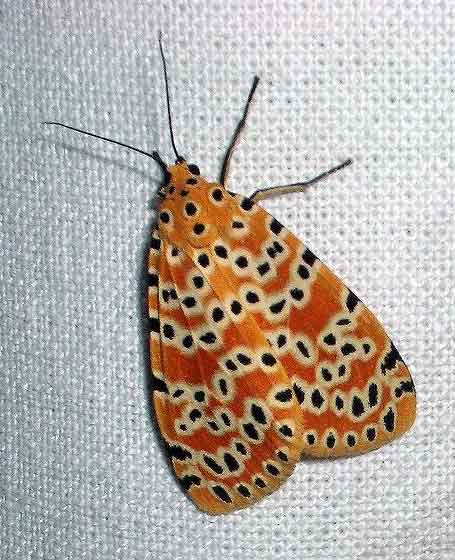
Argina astrea (*)
Superregnum: Eukaryota
Cladus: Unikonta
Cladus: Opisthokonta
Cladus: Holozoa
Regnum: Animalia
Subregnum: Eumetazoa
Cladus: Bilateria
Cladus: Nephrozoa
Cladus: Protostomia
Cladus: Ecdysozoa
Cladus: Panarthropoda
Phylum: Arthropoda
Subphylum: Hexapoda
Classis: Insecta
Cladus: Dicondylia
Subclassis: Pterygota
Cladus: Metapterygota
Infraclassis: Neoptera
Cladus: Eumetabola
Cladus: Endopterygota
Superordo: Panorpida
Cladus: Amphiesmenoptera
Ordo: Lepidoptera
Subordo: Glossata
Cladus: Coelolepida
Cladus: Myoglossata
Cladus: Neolepidoptera
Infraordo: Heteroneura
Cladus: Eulepidoptera
Cladus: Ditrysia
Cladus: Apoditrysia
Cladus: Obtectomera
Cladus: Macroheterocera
Superfamilia: Noctuoidea
Familia: Erebidae
Subfamilia: Arctiinae
Tribus: Arctiini
Subtribus: Nyctemerina
Genus: Argina
Species: Argina astrea
Name
Argina astrea (Drury, 1773)
Synonyms
astraea auct.
Phalaena cribraria Clerck, 1759 [1764]
Bombyx pylotis Fabricius, 1775
Deiopeia dulcis Walker, 1854
Xanthestes guttata Rambur, 1866
Argina notata Butler, 1877
References
Butler, A.G., 1877: On the Lepidoptera of the family Lithosiidæ, in the collection of the British Museum. The Transactions of the Entomological Society of London 1877: 325–377, pl. VIII, London.
Clerck, C, 1759: Icones Insectorum Rariorum cum nominibus eorum trivialibus, locisque e C.Linnaei Arch. R. et Eqv. Aur. Syst. Nat. allegatis: 1–99, pl. 1-98, Holmiae.
Drury, D., 1773: Illustrations of Natural History. Wherein are exhibited upwards of two hundred and twenty figures of exotic insects, according to their different genera; very few of which have hitherto been figured by any author, being engraved and coloured from nature, with the greatest accuracy, and under the author’s own inspection, on fifty copper-plates. With a particular description of each insect; interspersed with remarks and reflections on the nature and properties of many of them 2: 1–92, 50 pl., London.
Fabricius, I. C., 1775: Systema entomologiae, sistens insectorum classes, ordines, genera, species, adjectis synonymis, locis, descriptionibus, observationibus: [32]+832 pp., Flensburgi et Lipsiae.
Rambur, P., 1866: Catalogue systématique des lépidoptères de l'Andalousie (2): 93–412, Pl. XI-XXII, J.B. Bailliçre:Paris.
Walker, F., 1854: List of the Specimens of Lepidopterous Insects in the Collection of the British Museum 2: 279–581, Edward Newman: London.
Argina astrea, the crotalaria podborer, is a moth of the family Erebidae. The species was first described by Dru Drury in 1773. It is found in eastern Africa, southern Asia of India, Sri Lanka, and Indo-Australia, including the Pacific Islands and Australia.
Description
The wingspan is about 40 mm. The species is extremely variable in wing pattern as well as ground colour. It differs from Mangina argus in the head, thorax and forewing being orange yellowish or whitish. The abdomen and hindwings are bright orange. Markings and spots are similar to its neighbor species.[1] The head of the caterpillar is reddish brown when fully grown. Its body is black with white intersegmental rings that contain broken black transverse lines. Spiracles are in orange patches.[2]
Ecology
The larvae feed on Crotalaria species. The species prefers secondary habitats ranging from the lowlands to the montane region.[3]
Subspecies
Argina astrea astrea (China (Yunnan, Hong Kong, Zhejiang, Guangdong), Taiwan, Bangladesh, India, Sri Lanka, Nepal, Myanmar, Philippines, Japan (Ryukyu), Indochina, Indonesia, New Guinea, Australia, Oceania, eastern Africa, Ghana, Madagascar, Seychelles)
Argina astrea pardalina Walker, 1864 (eastern Africa, Madagascar)
References
Hampson, G. F. (1894). The Fauna of British India, Including Ceylon and Burma: Moths Volume II. Taylor and Francis – via Biodiversity Heritage Library.
Holloway, Jeremy Daniel. "Argina astrea Drury". The Moths of Borneo. Retrieved 24 July 2016.
Černý, Karel (January 3, 2011). "A Review of the subfamily Arctiinae (Lepidoptera: Arctiidae) from the Philippines" (PDF). Entomofauna. 32 (3): 29–92.
Retrieved from "http://en.wikipedia.org/"
All text is available under the terms of the GNU Free Documentation License

